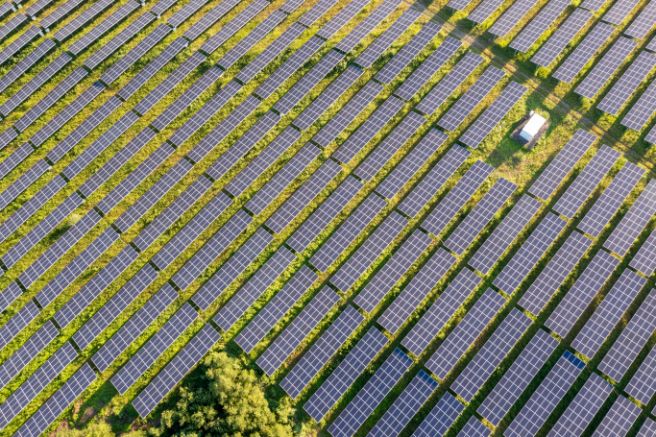Solar energy, a virtually untapped wellspring of power, carries the potential to revolutionize the global energy landscape, transforming societies into cleaner, more sustainable, and energy-independent entities. However, the vast capabilities of this abundant resource were largely under-realized, hindered by a set of technological, economic, and regulatory constraints. But in this continuously evolving space, it’s critical to recognize that innovative advancements, conducive policy shifts, and novel business models are steadily emerging, all striving to unlock the prodigious potential of solar energy.
Solar energy is a powerful and plentiful resource that, was still underutilized due to technical, economic, and regulatory challenges. However, ongoing developments in technology, policy, and business models are helping to unlock its enormous potential. Let’s examine how this potential can be opened further:
- Efficiency Improvements: By improving the efficiency of solar cells, we can generate more energy from the same amount of sunlight. Current commercial solar panels usually convert about 15-22% of solar energy into electrical energy. Advanced solar cells in the lab can achieve efficiencies above 40%, so there’s considerable room for growth.
- Cost Reduction: While solar panel costs have dropped significantly over the years, further reduction can make solar power more accessible. Cost reductions can come from improvements in manufacturing processes, economies of scale, innovations in design and materials, and reductions in installation and maintenance costs.
- Energy Storage: One of the major challenges with solar energy is its intermittent nature – it’s only available when the sun is shining. Improvements in energy storage technology, such as more efficient and cost-effective batteries, can help store excess power generated during the day for use at night or during cloudy periods. Grid-level energy storage solutions can also be explored to deal with this issue.
- Grid Integration and Smart Grids: Efficient integration of solar energy into the existing power grid is crucial. This includes improving grid infrastructure to handle variable renewable inputs, implementing demand response strategies, and using advanced grid management technologies. The development of ‘smart’ grids, which can balance energy supply and demand in real-time, is a promising approach.
- Policy and Regulatory Support: Governments can play a critical role in advancing solar energy by offering incentives (like tax credits or feed-in tariffs), funding research and development, removing regulatory barriers, and promoting solar energy use in public buildings and infrastructure.
- Public Awareness and Education: Many people are unaware of the benefits of solar energy or have misconceptions about its costs and feasibility. Public education and awareness campaigns can help to address this.
- Decentralized Energy Production: Solar panels can be installed on individual homes, businesses, or community buildings, allowing for decentralized energy production. This not only reduces transmission losses but also increases energy security and resilience.
- Innovation in Business Models: New business models, such as solar leasing or power purchase agreements, can reduce the up-front costs of installing solar panels, making solar energy more accessible to a wider range of people.
- Hybrid Systems: Combining solar power systems with other renewable energy sources (like wind or hydropower) or with traditional energy sources can help overcome the limitations of solar power and ensure a steady power supply.
Unlocking the full potential of solar energy requires a multi-faceted approach that includes technology advancements, cost reductions, policy support, and public education. But with concerted effort and investment, solar energy can become a central pillar of a sustainable energy future.
Efficiency Improvements
 Improving the efficiency of solar cells is an essential step in maximizing the potential of solar energy. Currently, the standard commercial solar panels convert approximately 15-22% of solar energy into usable electricity. Although this percentage might seem low, it’s a significant improvement from where we started.
Improving the efficiency of solar cells is an essential step in maximizing the potential of solar energy. Currently, the standard commercial solar panels convert approximately 15-22% of solar energy into usable electricity. Although this percentage might seem low, it’s a significant improvement from where we started.
However, we are still far from reaching the limit of what is technically achievable. Emerging technologies and experimental solar cells in laboratory settings have demonstrated conversion efficiencies above 40%. These high-efficiency cells typically use advanced designs and materials, such as multi-junction cells that can capture more of the solar spectrum or perovskite cells that offer high efficiencies at a potentially lower cost.
Yet, transitioning these high-efficiency cells from the lab to widespread commercial deployment presents a range of challenges, including manufacturing complexity, durability, and cost. Ongoing research and development are striving to overcome these obstacles, which will unlock even greater power output from the same amount of sunlight.
By boosting solar cell efficiency, we not only increase the amount of power that can be generated from a given area of solar panels, but we also improve the economics of solar power, as less space and fewer panels are needed to generate the same amount of power. This is particularly important in areas where space is at a premium, such as rooftops in dense urban areas.
In the future, the combination of high-efficiency solar cells, advanced manufacturing techniques, and economies of scale could transform solar power into one of the most affordable and abundant sources of electricity worldwide.
Cost Reduction
Reducing the costs associated with solar power is a vital element in promoting its widespread adoption. Indeed, the price of solar panels has significantly decreased over the years, but there’s still a need for further reductions to make solar energy more accessible and competitive with other energy sources. Several strategies can be pursued to achieve these cost reductions:
is a vital element in promoting its widespread adoption. Indeed, the price of solar panels has significantly decreased over the years, but there’s still a need for further reductions to make solar energy more accessible and competitive with other energy sources. Several strategies can be pursued to achieve these cost reductions:
Improvements in Manufacturing Processes
Enhancements in production techniques can make solar panel manufacturing more efficient, thus reducing costs. For instance, thin-film solar technology uses less material than traditional silicon panels, and next-generation solar technologies like perovskite solar cells can potentially be manufactured using cost-effective methods like roll-to-roll printing.
Economies of Scale
As the demand for solar panels increases, manufacturers can produce larger quantities at a lower cost per unit. This is particularly true for new technologies, where the initial production runs are often expensive due to the costs of setting up new manufacturing lines.
Innovations in Design and Materials
The use of novel materials and design approaches can help to reduce costs and increase efficiency. For example, bifacial solar panels can produce electricity from both sides, increasing output without a corresponding increase in cost.
Reductions in Installation and Maintenance Costs
Solar panel installation and maintenance represent a significant portion of the overall cost of solar power. Improvements in these areas, such as simplified mounting systems, automated cleaning systems, or drone-based inspection systems, can lead to considerable cost savings.
Finally, it’s worth noting that while upfront costs are a significant factor in the adoption of solar power, the long-term economics are often favorable. Solar panels produce electricity for 25 years or more, and once the initial investment is paid off, the electricity they produce is essentially free.
By reducing costs through manufacturing efficiency, scale, design innovation, and installation and maintenance improvements, solar power can become even more affordable, contributing to a faster transition to renewable energy.
Energy Storage
 Overcoming the intermittent nature of solar energy – its availability only when the sun is shining – is a significant obstacle in harnessing its full potential. Energy storage technologies serve as a critical solution to this problem, enabling the capture of excess power generated during the day for later use, especially during nighttime or overcast periods.
Overcoming the intermittent nature of solar energy – its availability only when the sun is shining – is a significant obstacle in harnessing its full potential. Energy storage technologies serve as a critical solution to this problem, enabling the capture of excess power generated during the day for later use, especially during nighttime or overcast periods.
Advanced battery technologies are at the forefront of this solution. Lithium-ion batteries, which have seen substantial reductions in cost and increases in efficiency over the years, are currently the most commonly used for energy storage. They are becoming increasingly common in homes with solar panels and utility-scale solar farms. These batteries can store surplus energy generated during peak sun hours and then dispatch this stored energy during periods of high demand or low solar production.
However, the quest for more cost-effective and higher-capacity battery technologies is ongoing. Emerging technologies, such as solid-state batteries, flow batteries, and even the development of next-generation lithium-sulfur and lithium-air batteries, hold great promise for improving energy storage capabilities.
In addition to batteries, other energy storage technologies can play a role in tackling the intermittency of solar power. These include pumped hydro storage, thermal energy storage, and even novel concepts like storing energy in the form of compressed air or gravitational potential energy.
Furthermore, on a broader scale, grid-level energy storage solutions are being explored to stabilize energy supply across regions. By storing excess renewable energy on a large scale, utilities can better manage their grids, reducing the need for fossil fuel-powered backup generators and making the entire power system more resilient and sustainable.
Ultimately, advancements in energy storage technologies are key to unlocking the full potential of solar energy, turning it from an intermittent energy source to a reliable, around-the-clock supplier of clean electricity. With continued research and investment in this field, we can expect to see a future where the sun’s power is harnessed day and night.
Grid Integration and Smart Grids
Integrating solar energy into the existing power grid efficiently and effectively is another essential aspect of unlocking its potential. This challenge arises from the variable nature of solar power – its generation peaks during the day, especially in clear weather, and drops to zero at night or during heavy cloud cover. This variability can cause instability in the power grid, which is designed for the steady output of traditional power plants.
efficiently and effectively is another essential aspect of unlocking its potential. This challenge arises from the variable nature of solar power – its generation peaks during the day, especially in clear weather, and drops to zero at night or during heavy cloud cover. This variability can cause instability in the power grid, which is designed for the steady output of traditional power plants.
To address this, we must enhance the grid infrastructure to better handle the influx of renewable energy. This includes upgrades to transmission and distribution systems and the deployment of advanced grid management technologies to manage the flow of electricity effectively.
Implementing demand response strategies is another approach to better align energy supply and demand. In a demand response scenario, utilities incentivize consumers to reduce their energy use during peak demand periods or shift their use to off-peak periods when more renewable energy may be available.
However, one of the most promising approaches is the development of ‘smart’ grids. A smart grid uses digital technology and advanced communication systems to monitor and manage the flow of electricity from all generation sources in real time. It can adapt to changes in supply and demand, integrate large amounts of renewable energy, and even enable two-way energy flows where customers can both draw electricity from the grid and feed electricity into it (such as from rooftop solar panels).
A smart grid can also support distributed energy resources (DERs), including residential solar panels, local wind turbines, and energy storage systems. This allows for greater flexibility and resiliency of the grid, with the ability to isolate from the broader network during disruptions or emergencies and to continue operating independently – a capability known as ‘islanding’.
Effective grid integration and the transition to smart grids can address many of the challenges associated with solar energy’s intermittency, allowing for a more resilient, efficient, and renewable-friendly grid. This is not only crucial for harnessing the full potential of solar energy but is also a key step toward a more sustainable and reliable energy future.
Policy and Regulatory Support
Government policy and regulatory support play a crucial role in advancing solar energy technology and its widespread deployment. Despite the significant strides made in reducing costs and improving the efficiency of solar panels, government intervention can further incentivize the adoption of solar energy and boost research and innovation in the sector. There are several ways in which governments can support the development and deployment of solar energy:
play a crucial role in advancing solar energy technology and its widespread deployment. Despite the significant strides made in reducing costs and improving the efficiency of solar panels, government intervention can further incentivize the adoption of solar energy and boost research and innovation in the sector. There are several ways in which governments can support the development and deployment of solar energy:
Incentives
Policies such as tax credits, rebates, feed-in tariffs, or net metering can significantly reduce the cost of installing solar panels for homes and businesses, making solar energy more financially appealing. For instance, the Investment Tax Credit (ITC) in the United States has been a significant driver for solar adoption.
Research and Development Funding
Governments can allocate funds toward research and development in the solar energy sector. This could help in the development of more efficient solar panels, cheaper manufacturing methods, and better energy storage solutions.
Removing Regulatory Barriers
Regulations can sometimes hinder the adoption of solar energy. For example, some local building codes or homeowners’ association rules might restrict the installation of solar panels. Governments can work towards identifying and removing such regulatory barriers.
Public Use of Solar Energy
Governments can set an example by integrating solar energy into public buildings and infrastructure. This not only reduces the carbon footprint of government operations but also demonstrates the viability of solar energy to the wider public.
Long-Term Targets and Renewable Portfolio Standards
Governments can set long-term targets for renewable energy adoption, providing certainty for investors and spurring the industry to meet these goals. Similarly, Renewable Portfolio Standards (RPS) or mandates can require utilities to source a certain percentage of their power from renewable sources.
Education and Training
Governments can support education and training programs in the solar sector, ensuring that there is a skilled workforce ready to support the growing solar industry.
Policy and regulatory support from governments can accelerate the development and adoption of solar energy, helping to unlock its full potential as a significant contributor to our future energy mix. By implementing forward-thinking policies and regulations, governments can facilitate a faster and smoother transition to a sustainable, solar-powered future.
Public Awareness and Education
 The importance of public awareness and education in advancing solar energy cannot be overstated. Despite the many strides made in solar technology and its growing presence in our energy mix, misconceptions and lack of awareness can still pose significant barriers to its wider adoption.
The importance of public awareness and education in advancing solar energy cannot be overstated. Despite the many strides made in solar technology and its growing presence in our energy mix, misconceptions and lack of awareness can still pose significant barriers to its wider adoption.
Many people are not fully aware of the numerous benefits that solar energy provides, including its environmental advantages, its potential for energy independence, and its increasingly competitive costs. Some common misconceptions include the belief that solar panels do not work in cloudy or cold climates, that they require constant maintenance, or that they are still too expensive for the average homeowner.
Public education and awareness campaigns can help dispel these myths and provide clear, accurate information about solar energy. These initiatives can take various forms:
Informational Campaigns
Governments, non-profit organizations, and solar companies can run informational campaigns to educate the public about the benefits of solar energy and the realities of its costs and installation.
School Programs
Integrating renewable energy topics into school curricula can help foster awareness and interest from a young age. This could also extend to university-level courses and research programs, preparing the next generation of engineers and scientists to contribute to the field.
Community Projects
Community-based solar projects or “solar gardens” can serve as a practical demonstration of solar energy, allowing community members to invest in and benefit from solar power even if they cannot install panels on their property.
Workshops and Seminars
Workshops and seminars can provide more in-depth information and practical advice for those considering a solar installation.
Online Platforms and Social Media
In today’s digital age, online platforms and social media can be powerful tools for disseminating information and engaging with a wide audience.
By educating the public and raising awareness of solar energy, we can address misconceptions, increase acceptance, and encourage more people to consider solar power as a viable and sustainable energy option. This is a vital component in unlocking the full potential of solar energy and moving towards a cleaner, more sustainable future.
Decentralized Energy Production
The decentralization of energy production through solar power holds great promise for enhancing energy security, increasing grid resilience, and promoting sustainability. This paradigm shift changes the traditional model of large-scale, centralized power plants delivering energy to consumers through long-distance transmission lines. Instead, it enables homes, businesses, and community buildings to become producers of their power through the installation of solar panels.
Reduced Transmission Losses
Energy losses that occur when electricity is transmitted over long distances can be significantly reduced. With local production, the electricity generated by solar panels is consumed where it is produced, minimizing these losses.
Increased Energy Security
Decentralized energy production can enhance energy security by reducing dependence on large-scale power plants and fossil fuel imports. Each unit of solar power generated locally is a unit less that needs to be produced elsewhere and transported to the location.
Resilience to Power Outages
Distributed solar systems, especially when paired with energy storage, can provide a degree of resilience to power outages. If a central power plant fails or the transmission grid is disrupted, homes and buildings with solar power can continue to operate. This can be particularly vital during natural disasters or other emergencies.
Economic Benefits
Decentralized solar power can provide economic benefits by creating local jobs in installation, maintenance, and support services. It also allows individuals and businesses to save money on their energy bills and even earn money by selling surplus power back to the grid, depending on local regulations.
Environmental Impact
By reducing reliance on fossil fuel-based power generation, decentralized solar power can contribute to significant reductions in greenhouse gas emissions.
Despite these benefits, achieving a widespread shift to decentralized solar power also involves challenges, including regulatory barriers, the need for more flexible grid management systems, and ensuring the affordability of solar installations. However, with the right policies, technologies, and public awareness, decentralized energy production through solar power can play a critical role in transforming our energy system for a sustainable future.
Innovation in Business Models
Innovation in business models can be a significant driver in expanding the adoption of solar energy. While the cost of solar panels and installation has dramatically decreased over the past decades, the upfront cost can still be a barrier for many individuals and businesses. Innovative financing and business models can help overcome this obstacle, making solar energy more accessible and affordable.
Solar Leasing
In a solar lease, a third party owns the solar system and takes on the responsibility of installation, maintenance, and repairs. The homeowner simply pays a monthly lease payment for the use of the system and benefits from the electricity it produces. This arrangement allows homeowners to take advantage of solar power without the upfront costs or the responsibility of owning and maintaining the system.
Power Purchase Agreements (PPAs)
In a PPA, a third-party developer installs, owns, and operates the solar system. The customer agrees to purchase the system’s electricity output for a predetermined period, usually at a lower price than the local utility’s rate. Like solar leasing, this model allows customers to benefit from solar power without the upfront costs or maintenance responsibilities.
Community Solar Projects
Also known as solar gardens or shared solar, these projects allow multiple participants to invest in and benefit from a single solar installation. This model is ideal for individuals who cannot install solar panels on their property due to unsuitable conditions or because they rent their homes.
Solar-as-a-Service (SaaS)
Similar to other “as a service” business models, SaaS allows businesses to benefit from solar power without the need to own and maintain the solar system. The service provider installs the system and the business pays for the solar power it uses, often at a lower rate than traditional electricity.
Green Bonds and Crowdfunding
These financing models allow investors to fund renewable energy projects, including solar installations. This not only provides the necessary capital for these projects but also allows investors to contribute to sustainable initiatives.
By reducing the financial barriers to solar energy, these innovative business models can help accelerate its adoption. They provide options for almost anyone to benefit from solar power, regardless of their financial situation or the suitability of their property for a solar installation. As we continue to develop and refine these models, solar energy becomes an increasingly accessible and attractive solution for our energy needs.
Hybrid Systems
Hybrid energy systems , which integrate solar power with other renewable or traditional energy sources, offer a promising solution to the inherent intermittency of solar power. By combining different sources of energy, these systems can balance the fluctuations in power output and ensure a more consistent and reliable supply of electricity.
, which integrate solar power with other renewable or traditional energy sources, offer a promising solution to the inherent intermittency of solar power. By combining different sources of energy, these systems can balance the fluctuations in power output and ensure a more consistent and reliable supply of electricity.
Solar-Wind Hybrid Systems
These systems combine solar panels with wind turbines. While solar power generation peaks during the day and decreases at night, wind power can often complement this as winds can be stronger and more consistent during the night or certain seasons.
Solar-Hydro Hybrid Systems
These systems integrate solar power with hydropower. While solar power is variable, hydropower can be relatively consistent, especially with a reservoir for energy storage. During the day, excess solar power can also be used to pump water back into the reservoir, effectively storing the energy for later use.
Solar-Gas Hybrid Systems
These systems combine solar power with a gas-fired generator. When solar power is insufficient (such as at night or during cloudy weather), the gas generator can kick in to supplement the power supply.
Solar-Battery Systems
While not a hybrid in the traditional sense, these systems deserve mention. They combine solar panels with a battery storage system. During the day, excess solar power charges the battery, and then the stored power can be used when solar power generation is low or nonexistent.
Each type of hybrid system has its advantages and is suited to different situations depending on the available resources, climate, and specific power requirements. By balancing the strengths and weaknesses of different energy sources, hybrid systems can provide a reliable, continuous power supply, making them an attractive option for both grid-connected and off-grid power systems. As we continue to develop and refine these technologies, hybrid systems will play a crucial role in our transition to a more sustainable and resilient energy future.
Solar energy’s immense potential can be unlocked through a comprehensive approach that integrates technological advancements, cost-cutting measures, policy support, and public awareness initiatives. While fully utilizing solar power may seem arduous, it’s worth remembering that every small stride is a step toward a greener, cleaner, and more sustainable future. By diligently and consistently pursuing these strategies, we can elevate solar power from being a mere alternative to a primary energy source. Through collective effort and investment, we can all play a part in pushing solar energy into the mainstream, powering the world toward a sustainable energy future.



